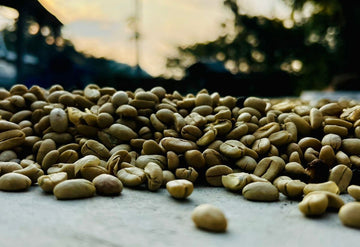Exploring The Origins: Justin’s Journey To Cafe Justicia In Guatemala
by Daria Toptygina on Feb 12, 2024

A few months ago, Leocadia Juracan, a Member of Cafe Justicia, was brought in with Steve Stewart, the Rep for Cafe Justicia and BC CASA, for a tour of Equator Coffee Roasters. BC CASA is a volunteer group based in Vancouver that advocates for Cafe Justicia by importing and selling their green coffee beans from Guatemala into Canada (1). It was at that point during the tour that they presented Justin Houle, our Head Roaster, with a unique opportunity: to join them on a roaster trip Steve had planned to visit the Cafe Justicia coffee mill in Guatemala, which was Justin’s first major trip outside of Canada.
Read on to learn more about Justin’s java-filled journey to Cafe Justicia in Guatemala.
The Prelude To The Journey:
Our roaster embarked on the trip with other roasters representing their cafes across Canada, including Ontario-based roasters from Little Victories in Ottawa and Eco Coffee from Toronto, and British Columbia-based roasters from Oso Negro in Nelson and Bean Around the World Coffees in Vancouver.
All of these roasters roast Cafe Justicia’s coffee, and there were two roasters from each cafe on this trip.
But before the trip, Justin was nervous, not just because he was the sole person from Equator to go, but he was also visiting a new region, prior to which he had only travelled a couple of times to the US. His initial impression was feeling a bit overwhelmed being in Guatemala for the first time witnessing its landscapes and coffee farms, though soon he uncovered the rich coffees and richer lives of the farmers in the region.
Unveiling The Coffee Farms And Cooperatives:
Throughout his journey, Justin visited Antigua and the endorheic Lago de Atitlán, which is a lake situated within a massive volcanic crater in the southwestern highlands of Guatemala and includes the lava dome known as Cerro de Oro, or “Hill of Gold,” on the northern foot of the Tolimán Volcano, and San Antonio.
(I had the privilege of getting to try a delicious coffee from De La Gente during this interview that Justin made via French Press, which is a company that operates with some small producers outside of Antigua.)
For Justin, it was clear to see how embedded and communal coffee was within Guatemalan culture.
A lot of the farmers he spoke with still made the time to grow coffee as a part-time job on the weekends even though many of them had full-time jobs that were not coffee-based, such as teachers or construction workers. It was only after making it into the higher ranks could these farmers grow coffee full-time to make a living. But in the meantime, growing coffee, which takes up a lot of resources itself, is a way for farmers to make a fair bit of extra income to help support their families and stay above the poverty line.
Justin was able to go around to various farms and see how each of them was set up in a slightly different way. One in particular stood out to him: a coffee farmer had beehives on her farm to help promote the growth of her other plants and improve the overall health of her crops. She also harvested her own honey to sell on the local market, which Justin got to try. He said it was some of the best honey he had ever had.
Challenges And Opportunities For Coffee Farmers:
With poverty being such a prevalent issue, it is important for local farmers to be a part of a big cooperative like Cafe Justicia and De La Gente, which provides them with the opportunity to get more money for their crops and to produce better yields.
Another issue, especially with the challenges inherent in climate change in that area, is the rise in coffee leaf rust disease, or roya, which is the Spanish term for it.
“On our adventures we’ve actually seen farms just abandoned because of it, so it provides an interesting contrast of . . . two farms right beside each other: one was abandoned, and one is recovering from roya,” says Justin.
Since those privately-owned farms are not under Cafe Justicia’s control, the farmers whose crops were ravaged by coffee leaf rust have fled. To be able to get those farms back to a usable quality would necessitate a five to ten-year process of extensive renovations, such as tearing up the old coffee plants and planting new crops over where they were to reinvigorate the soil and re-balance the nutrients.
Despite these significant challenges, there are still opportunities for these coffee farmers. After all, the main reason for the trip was to visit Cafe Justicia’s roastery to see how they operate and to offer any input that might help them change up their profiles. Justin, plus a roaster from Bean Around The World and one from Oso Negro, helped teach them more about profiling, how to do it, and what the ideal times are for roasting to get the most flavorful coffees. Granted, this always depends on the kinds of roasts desired, but ultimately there is a sort of fool-proof formulaic approach, which Justin and the team were able to use via their insights to improve Cafe Justicia’s light and dark roasts after only two or three roasts on their roaster.
Sustainability And Community-Focused Initiatives:
The tour guides on the trip were members of the Cafe Justicia Cooperative. They explained how they generate their own food, such as tilapia, herbs, vegetables, fruits, proteins, beans, bananas, and avocados, which is all locally grown, primarily in one crop-rich section by a river. Anything that is not usable is typically sold back down at the local market to generate profit to reinvest into their own project.
At coffee mills, they reuse water as much as possible while processing their coffee, oftentimes getting two or three uses out of it before diverting it to a sink of four connected concrete basin blocks full of lava stones. This helps to filter out any coffee cherry residue and lowers its acidity to non-harmful levels.
Biodiversity, Memorable Tastings, And Brewing Experiences:
The most common coffees that grew in the area were Arabica, Yellow Bourbon (which is a type of Arabica), Caturra (which is a natural mutation of Bourbon), Catimor (which is part Caturra and part Timor, the latter which is part Robusta and part Arabica), Catuai (which is a mix of two natural Arabica mutations, Mundo Novo and Yellow Caturra), and Pache (which is a natural mutation of Arabica Typica). There was also Geisha (which is another type of Arabica) growing on some of the farms.
Justin was fascinated to learn how Mayan ceremonies were performed before and after a coffee harvest. His eyes lit up as he recounted how he and his roaster group had the chance to participate. Through this truly unique and enjoyable experience, he learned more about the region’s culture and belief system.
He also noted that the coffees from Antigua and Lake Atitlán had very similar tastes, most likely because these regions are not too far from each other. After taking part in the sampling process, led by a SCA-certified cupper who followed all the standard SCA sampling protocols, he described all of the medium-roasted coffees’ profiles from the same crop as strong with a consistent citric acidity. He also found the primary tasting notes he sampled to include chocolate, cinnamon, and an assortment of berries.
For most of the farms that he went to with his roaster group, like one in San Miguel, they opted for cowboy coffee a lot of the time, which is different from the official cowboy coffee you may be familiar with (it entails sifting coffee through a sock.) In this version, it is more like a French Press: the water is boiled, then the grinds are added in, and after four or five minutes it is sifted out directly into the cups.
Roasting Differences:
Justin explained how the roasting methods differed between what he had seen on his trip compared to what he does with the Probat roaster here at Equator. In Guatemala, he saw how they traditionally roasted green coffee beans on a clay pan above a fire and moved them around on the pan until the desired first crack or second crack occurred. This allows for the freedom to roast the coffee in a wide variety of ways to elicit completely different flavor profiles.
Reflections On The Journey:
In his final reflection, Justin found it really cool how lava stones were used to grind coffee and cacao beans in traditional methods, and he is even looking for a way to get lava stones for himself! To use them, it requires you to wring your wrists and bring the roller up before crushing a few beans at a time, as if you were using a rolling pin. These stones are cylindrical and rest on a block that is also made of lava stones.
Conclusion:
The Origin Trip to Cafe Justicia in Guatemala offered Justin a once-in-a-lifetime opportunity to witness coffee-making through an entirely unique lens via new ways of farming, grinding, and roasting coffee. It reinforced Equator Coffee Roasters’ commitment to fostering meaningful connections with local farmers, sustainability, and ethical sourcing. As you sip your next cup of coffee from Equator, remember the skilled driven farmers and our talented diligent head roaster working hard to ensure you get the best possible start to your mornings.
Keep your eyes peeled for more Origin Trip stories as we continue to explore the rich world of coffee and share its beauty with you one brew at a time.
Daria Toptygina
Equator Coffee Roasters
References:
- Cafe Justicia. (n.d.). BC CASA. Retrieved February 11, 2024, from https://www.cafejusticia.ca/bc-casa/
